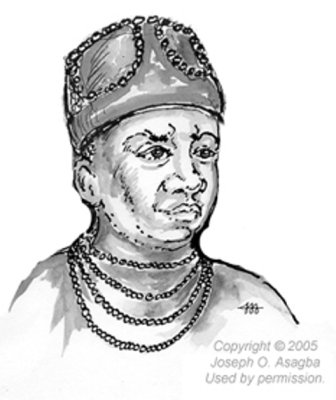|
Urhobo Historical Society |
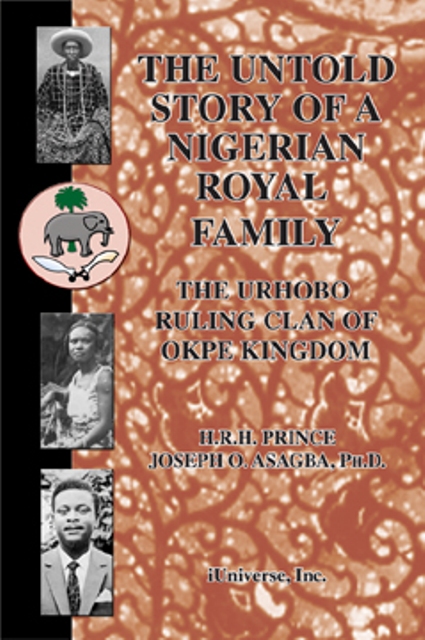
THE
UNTOLD
STORY OF A NIGERIAN ROYAL FAMILY:
The
Urhobo
Ruling Clan of
by H.R.H. Prince Joseph O. Asagba, Ph.D.
(
This book presents
the story
of the Urhobo ruling family of
- The Okpe revolution that led to the assassination of H.R.M. Esezi I in 1779
- British colonial rule of the kingdom during the late 1800s through 1960
- Civil war beween the Okpe and Olomu of Itsekiri in the 1800s and the palm oil trade rivalry
- Urhobo-Itsekiri collaboration in the slave trade, and slavery in eighteenth- and nineteenth-century Okpe.
It also examines the political role played by the traditional chiefs, the role of feminists who campaigned for women�s rights to participate in the all-male council of elders, and the effort by H.R.M. Esezi II to promote the democratic system of government within the Okpe council. It concludes with the story of the uncrowned king of Okpe Kingdom, including a brief history of the Nigerian Civil War of 1967-70, the reign of H.R.M. Orohoro I, and the story of the author�s candidacy for Okpe King after the death of Orhoro I. Postscripts include Nigeria oil policy, the Muslim-Christian strife, and human rights abuses.
Available in hardcover and paperback from:
And also from: www.bestbookprice.uk, www.bestbookdeal.com, www.powells.com,
www.category.org, www.fetchbook.info, www.8r.com, www.geometry.net,
www.literature-order-home.com, www.bookstore.co.uk
About the Author

Joseph Obukowho Asagba
Prince (Dr.) Joseph Obukowho Asagba is a descendant of Chief Asagba,
the
great-grandson of Prince Eyeyan Asagba, grandson of Prince Joseph
Etietsola
Asagba, and the eldest son of Prince Vann Etietsola Asagba of the
Orhoro ruling
house of
He received his B.S. from
He was born in
When Orhoro I, King of Okpe Kingdom, died in February 2004, a
descendant of the
Evwreke descent group was eligible for the throne. Joseph, who is also
a
descendant of the Evwreke lineage through his fathers mother, became a
candidate for the position of King. His candidacy was based on his
education
and experience in leadership. He is a modern prince, highly educated
and in
touch with the fast-changing world. Prince Joseph is regarded as a
moderate
among the Okpes and a progressive within the Okpe royal family. He is
chiefly
known as a member of the Okpe royal distinguished families of Asagba
and
Omarin.
In
his
application for the Okpe kingship, Joseph outlined some of his vision
for the
Okpe people, which includes:
1. To provide economic development, better education, and better health care, and
2. To work with oil companies on environmental
issues,
working for clean air and clean water standards, so all Okpes can enjoy
clean
and healthy communities.
Joseph was selected by his ruling house as their best candidate.
However,
members of the Orhue ruling house of
♣
♣
♣ ♣
THE ORIGIN AND A BRIEF HISTORY
OF THE URHOBO OKPE
By Prince Joseph O. Asagba, Ph.D.
Introduction
The Okpe people are
part of
the Urhobo ethnic group in the
The power and authority in
1. The Orodje (King)
2. The Otota (Speaker)
3. The Ekakuros (Chiefs)
The Orodje is the head of the kingdom and head of the Udogun Council,
which is
the supreme council of Okpe. The king is also the head and president of
the
Okpe Traditional Council.
The Otota is the spokesman in Okpe. In the event of the death of the
Orodje,
the most important spokesman in
The Chiefs are the representatives of the people and are members of the
four
ruling houses in Council (Asagba, 2005, p. 79).
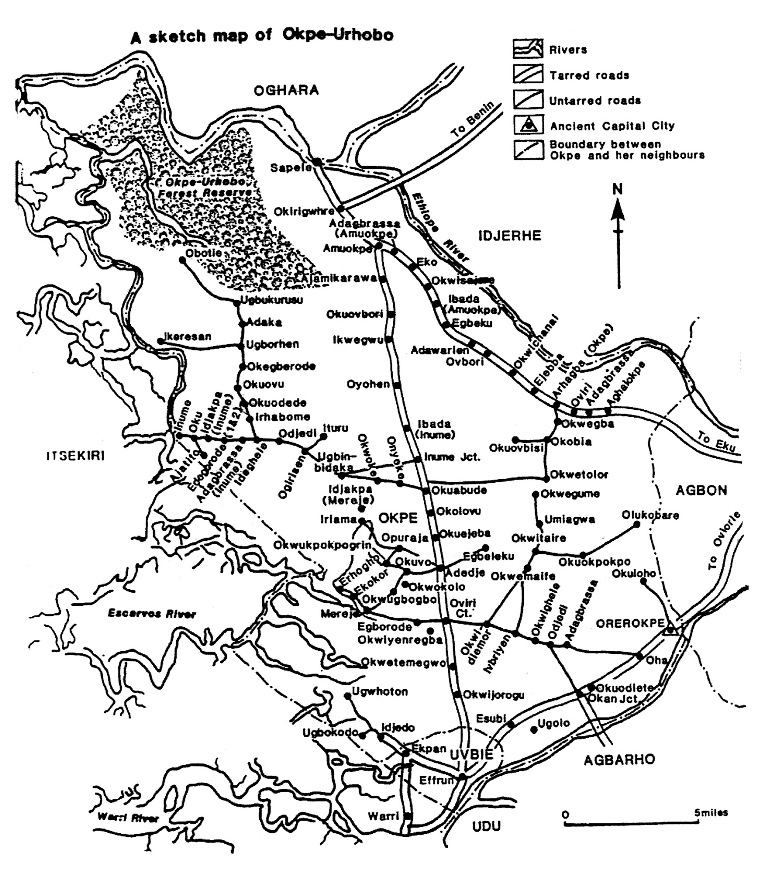
Migrations
Igboze (b. ca. late sixteenth century)
Prince Igboze is the founding father of the royal family of the Urhobo
Okpe
people. He was the son of an Oba (king) of Benin Empire. In the middle
of the
seventeenth century, he noticed the decline of the power of the Empire
and,
fearing for its future, determined to found his own kingdom. For this
purpose
he obtained his title of Ovie (king) from his second cousin, Oba
Ahenzae of
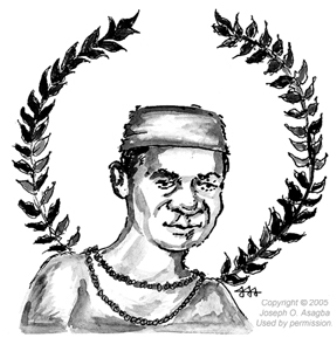
Okpe, Prince (b. 1664 � d. 1740)
Prince Okpe was the son of Prince Igboze, who was the son of an Oba (king) of the Benin Empire.
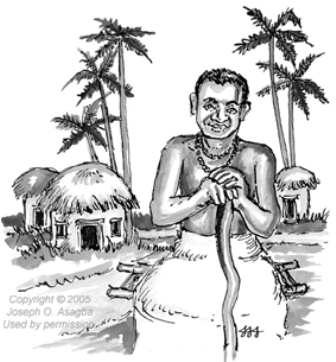
Orhue, Prince (b. 1694 � d. 1772)
The First Son of Prince Okpe
Prince Orhue was a
political
leader and a hunter who searched for food and a fertile region for
settlement.
Orhue lived in Agbarho, and later crossed the nearby stream and founded
Orerokpe, the present capital of
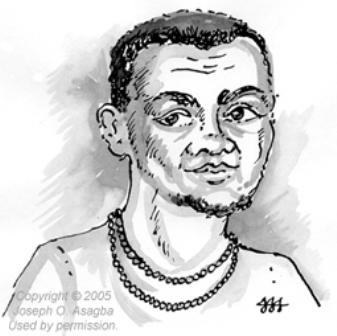
Orhoro, Prince (b. 1709 � d. 1781)
The Second Son of Prince Okpe
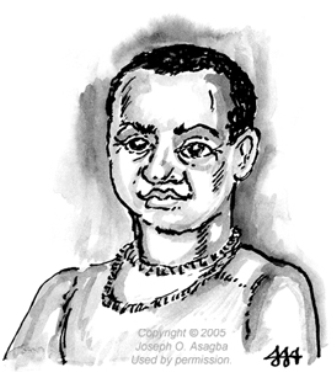
Evwreke, Prince(b. 1712 � d. 1780)
The Third Son of Prince Okpe
Both Orhoro and Evwreke became senior political leaders under the regime of their brother, H.R.M. Esezi I.
Kingship
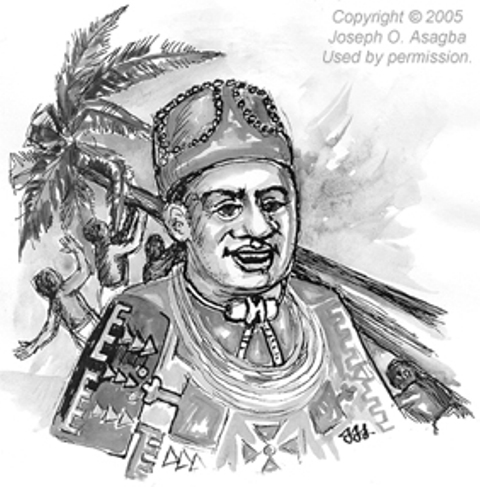
H.R.M.
Esezi I, King of
The Fourth Son of Prince Okpe
Reigned 1770-1779 (18th century)
According to the 1947 Okpe Chiefs
statement on
the traditional history of the kingship of Okpe, the Okpe people wanted
to have
a king to rule their domain so as to maintain peace, equity, and order
in their
traditional land, so Esezi, the son of Prince Okpe, was appointed as
the Orodje
of Okpe. He was installed by his senior brother, Orhue (Okpe State
Document,
1947). He installed Esezi because he was too old to rule and because
there was
a quarrel between the two other brothers Orhoro and Evwreke. Esezi
ascended the
throne as Esezi I, the Orodje of Okpe.
Esezi I�s installation caused controversy within the Okpes who felt he
was not
the right royal family member to be crowned. During his regime, Esezi I
ordered
his people to cut down large palm trees in order to see them crushed by
the
weight of the trees. He also ordered members of the ruling houses to
break a
huge bar of iron, and when they failed, ordered them killed. He was a
ruler who
violated his people�s human rights and did only as he wished.
In 1779, the Okpe people, tired of his brutal treatment of them, vowed
to kill
him. The people of Okpe secretly dug a pit, covered the pit with sticks
and
mats, and placed the king�s chair over the pit. They also prepared a
pot of
boiling palm oil. When they were ready, they called a meeting. When
Esezi I sat
on the chair, he fell into the pit. The people poured the boiling oil
and water
over him, and he died in agony, cursing the Okpes that they �will never
be
reunited under an Orodje� (Mebitaghan, 2001, p.6; Asagba, 2005). Esezi
I was
killed for undermining the Okpe constitution and failing to work within
its
framework (Ikoyo-Eweto, 2005). He also failed to embody the hopes and
symbols
of unity and happiness which formed the basis of the monarchial
government of
the Okpe people (Asagba, 2005).
After his death, the Esezi family were unhappy over the assassination
of their
leader, and there was great unrest in the state capital city of
According to Otite (1973), �the death of Esezi I occurred 150 years
before
1929, that is, in about 1779� (p. 61). Fellows (1928) confirmed that
Esezi I
was killed in the year 1779 (p. 6). After the assassination of Esezi I,
four
chiefs�Odorume of Orhue ruling house, Owhere of Orhoro ruling house,
and
Eruohwo and Ogoni, both of Evwreke ruling house�dominated Okpe
government and
politics, and redivided the whole kingdom, leaving no portion for the
Esezi
ruling house (Otite, 1973, p. 67; Asagba, 2005, chapter 2). This period
was
known as the Okpe Revolution (Asagba, 2005, chapter 2).
The assassination of Esezi I in 1779 and the revolution that followed
prompted
a split in the family and the migration of its branches to different
towns and
villages throughout
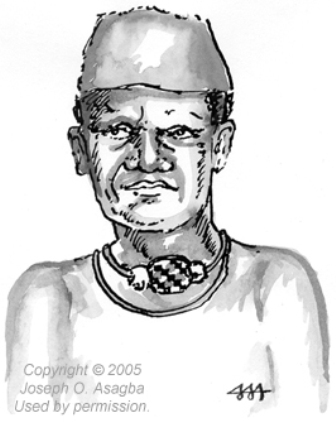
Chief Odorume (b. 1729 � d. 1796)
Son of Prince Orhue
He was a political leader from Orhue ruling house and a revolutionary.
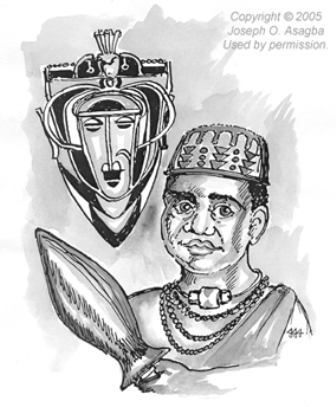
Son of Prince Orhoro
He was a political leader from the Orhoro ruling house and a revolutionary.
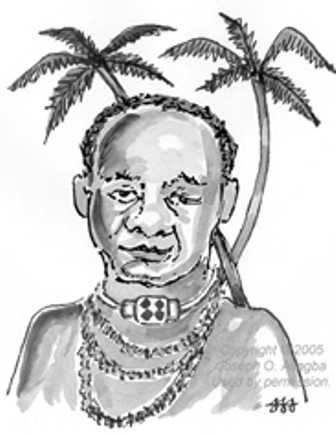
Chief Eruohwo (b. 1740 � d. 1802)
Son of Prince Evwreke
He was a political leader from the Evwreke ruling house and a revolutionary.
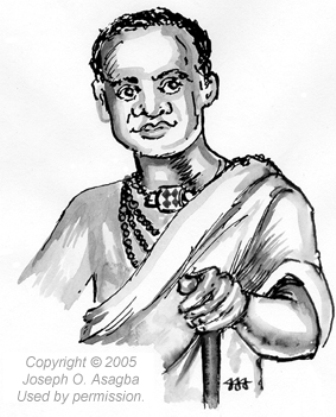
Chief Ogoni (b. 1745 � d. 1810)
Son of Prince Evwreke
He was a political leader from the Evwreke ruling house and a revolutionary.
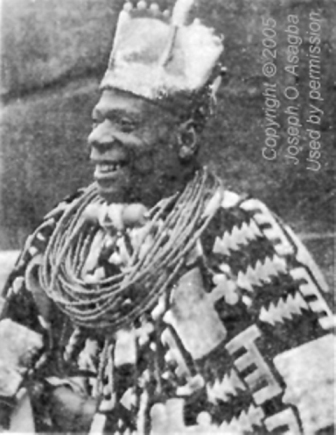
H.R.M.
Esezi II,
King of
(b. 1902 � d. 1966)
Reigned
1945-1966
(20th century)
Esezi II was born John Deveno to
the royal family of Mebitaghan of the Esezi family of Urhobo Kingdom of
Okpe.
In 1940, with the British indirect rule of the kingdom, the Okpe Union
saw the
urgent need to fill the vacancy created by the death of Esezi I. But
the
installation of Esezi II to the throne had to wait because the British
Colonial
government opposed his selection and refused to recognize him as the
Okpe king.
However, the Okpe people installed Esezi II as their king in January
1945, but
it was not until June 1948 that the Colonial government declared that
they
would recognize him as the Okpe king and that the Okpe people were free
to
regard and treat the king as their leader.
British rule marked the reign
(1945-1966) of Esezi II. He was the first Okpe king to rule under the
British
indirect government. During his reign, Esezi II worked to make the Okpe
kingship a democratic and constitutional monarchy. On March 16, 1957,
Esezi II
approved and signed into law the Okpe Tradition and Constitution, which
enabled
the democratic processes to begin functioning within the Okpe
Traditional
Council headed by the king.
When Nigerians began seeking
their independence from Great Britain, Esezi II was among the Nigerian
delegates of traditional kings who participated in the 1957 Lyttelton
Conference that was held in London to help seek Nigerian independence.
During his reign, Esezi II and
his council of chiefs became members of the House of Chiefs under the
Western
region of
Esezi II is remembered by the
Okpes as a ruler who brought his ideology of social equality to the
Okpe
monarchy by introducing a democratic system of government and as the
first Okpe
ruler to work with the British Colonial officers. Esezi II died in 1966
at the
age of sixty-four (Otite, 1973; Asagba, 2005).
Following the death of Esezi II,
and in accordance with the rotational system to the throne among the
four
ruling houses, the Orhoro ruling house was asked to present the
successor to
Esezi II. Prince Koyima Asagba of the Orhoro ruling house was selected
to be
the next king, but the Udogun Okpe Council rejected his nomination
because his
mother was an Itsekiri native. Following his rejection, Prince Vann
Etietsola
Asagba, a cousin to Koyima who was also from the Orhoro ruling house
(and his
mother�s father, Chief Omarin, was a member of the Evwreke ruling
house) was
nominated by the Asagba family. He had to turn down the nomination
because of a
split vote in the Asagba family. This action allowed Prince Domingo
Amujaine
Ejinyere to be appointed King of Okpe in 1972 after a six-year
interregnum
(Asagba, 2005).
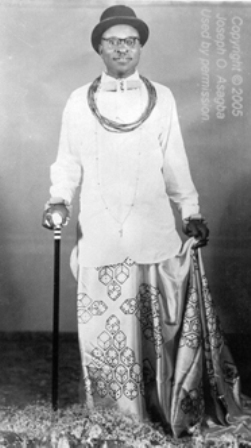
Asagba, Koyima G. (b. 1920 � d. 1974)
Prince Koyima G. Asagba was the son of Prince Gbabune Asagba and the grandson of Chief Asagba of the royal family of Asagba of the Urhobo Kingdom of Okpe.
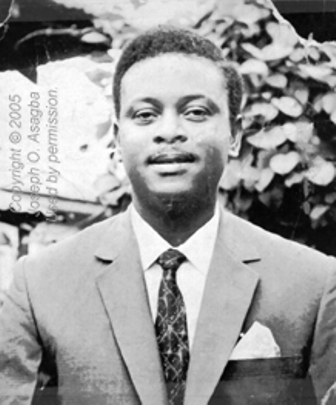
Asagba,
Vann
Etietsola (b. 1923 � d. 1997)
Prince Vann Etietsola Asagba was
the son of Prince Joseph Etietsola Asagba, grandson of Prince Eyeyan
Asagba,
and the great-grandson of Chief Asagba, born to the royal family of
Asagba of
the Orhoro ruling house of Urhobo Kingdom of Okpe. His mother was
Princess
Alberta Aduviere Omarin (b. 1900 � d. 1968), daughter of Chief Omarin
Etajeme
of the royal family of the Evwreke ruling house and of the Ogoni family
of
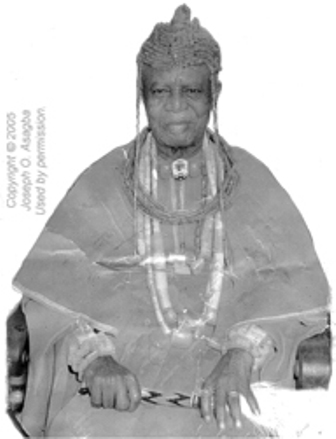
H.R.M.
Orhoro I, Orodje (King) of
Reigned
1972-2004 (20th-21st centuries)
HRM Orhoro I received his early
education at the
In 1964, His Royal Majesty, along
with his brother, Chief J. E. Odiete, jointly established an industrial
company
known as The New Africa Industries Limited. He held the positions of
Director
and General Manager of the company until his appointment as Orodje of
Okpe in
1972.
Since the installation of His
Royal Majesty Orhoro I, the Orodje had brought tremendous peace and
stability
to his people and also in the relationship between the Okpe people and
their
neighbors. He had reigned successfully and instilled relative peace,
discipline
and dignity in
During his reign, he was the
First Vice Chairman of the (then) Midwest Council of Traditional Rulers
(1973-1977); Deputy Chairman of the (then) Bendel State Traditional
Rulers
Forum (1977-1991); member of the National Council of States (1992);
first and
pioneer Chairman of the Delta State Council of Traditional Rulers
(1993);
Chairman, Southern Delta Traditional Rulers Forum and Chairman of the
Traditional Rulers of Oil Mineral Producing Communities in the Delta
State. He
was also the life president of the Okpe Traditional Council. During his
lifetime, His Royal Majesty won a Medal of Honor during the war of
1939-1945;
he received a commendation from the Police Command in 1950; and in
1978, he
became a Justice of the Peace. He received the Merit Award for the
Development
and Upliftment of Okpe Culture by the National Association of Okpe
Students at
the University of Benin/University of
His Royal Majesty Orhoro I passed
away in February 2004 at the age of 82. During the Orodje�s burial,
several
kings and chiefs who are members of the Nigeria Traditional Council
came to pay
their last respects. Among the prominent Nigerians who attended his
burial
ceremony were the former Nigeria Head of State, General Ibrahim
Babangida, and
the current governor of the Delta State, James Ibori (Eghagha, 2004).
Bibliography:
Asagba,
Joseph O. The Untold
Story of a Nigerian Royal Family: The Urhobo Ruling Clan of
Bradbury, R.
E. The
Eghagha,
Hope. �Celebrating the
life and time of HRM Orhoro I, JP, the Orodje of Okpe Kingdom� in Vanguard,
Fellows, L. E. H. �Report on the
Ukpe Sobo Clan� in
file C.S.O. 22/6/3/2/1943. National Archives,
Ikoyo-Eweto, Isaac P. �Cultural
Development in
Kerr, R. B. Ukpe Sobo Assessment
Report in file
C.S.O. 22/6/3/2/1943. National Archives,
Mebitaghan,
Isaac S. A Brief
History of
Otite, O. Autonomy
and
Dependence: The
Picture Credits.
Portraits of Princes Igboze, Okpe, Orhue, Orhoro, and Evwreke; Chiefs Odorume, Owhere, Eruohwo and Ogoni; and H.R.M. Esezi I are artist�s conceptions by James J. Johnson, Jr., Ed.D., professor emeritus, The University of North Texas, Denton, Texas.
Photos of H.R.M. Esezi II and H.R.M. Orhoro I courtesy of the collection of the Okpe Traditional Council.
Photo of
Prince Koyima G. Asagba and courtesy of Dr. Austin O. Asagba; photo of
Prince Vann Etietsola Asagba
courtesy of the private collection of the Asagba family.
